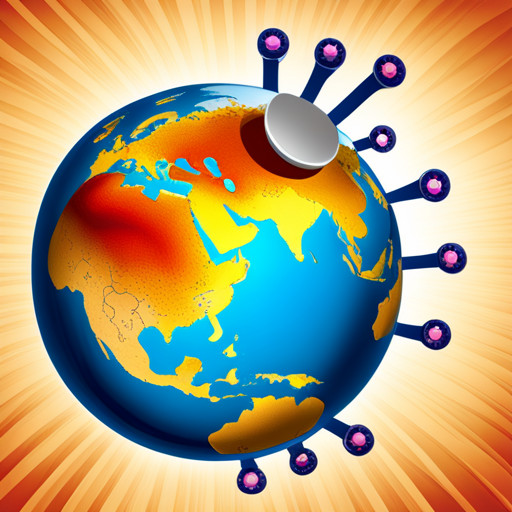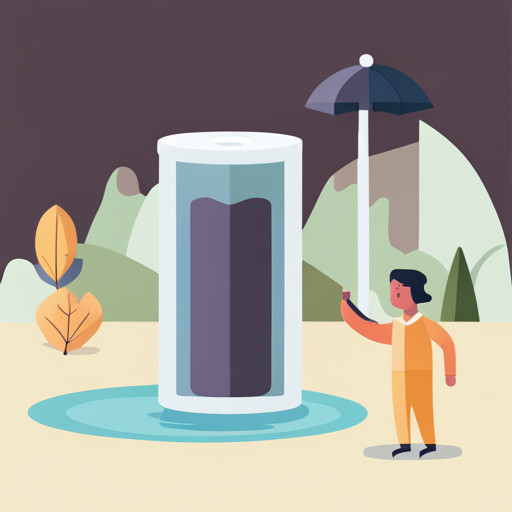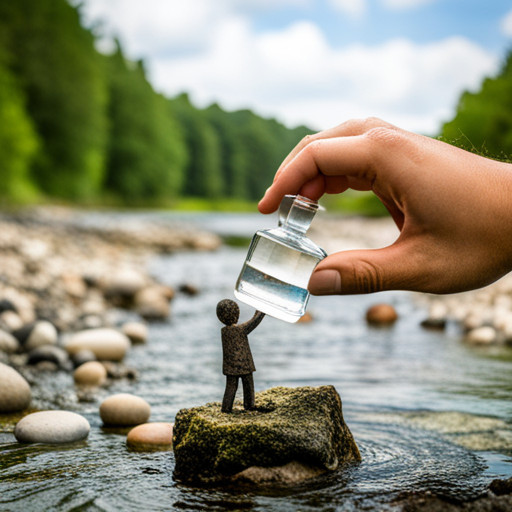Toxic Water A Silent Kidney Cancer Causer
Ironically, water, the essence of life, can also be a silent harbinger of death. This research article delineates the insidious connection between toxic water and kidney cancer, analysing various contaminants and their lethal impact on renal health.

Providing case studies, preventative measures, and exploring medical advancements, it underscores the urgent need for advocacy and policy changes to ensure access to clean water, a fundamental human right.
Key Takeaways
- Kidney cancer can develop due to various factors including genetic changes, lifestyle choices, environmental hazards, and chronic kidney diseases.
- Exposure to toxic elements in water, such as arsenic, lead, and mercury, has been linked to the development of kidney cancer.
- Preventative measures and water purification, such as home filtration systems, are important in reducing the risk of kidney cancer from toxic water.
- Strict laws and regulations should be enforced to monitor industrial activities that may lead to water contamination and ensure access to safe, clean water.
Understanding Kidney Cancer: An Overview

Kidney cancer, as a complex and multifaceted disease, requires comprehensive understanding of its origins, progression, symptoms, and potential treatment options. The origins and progression of kidney cancer can best be understood by studying the basics of renal anatomy and kidney cancer genetics.
Renal anatomy basics provide essential groundwork for comprehending kidney cancer. Kidneys, two bean-shaped organs located at the back of the abdomen, perform critical functions including removing waste products from the blood, regulating blood pressure, and producing hormones. Each kidney contains millions of nephrons, which filter the blood and produce urine. Understanding this complex structure is fundamental to grasping how abnormal cells multiply and form a tumor, leading to kidney cancer.
A deep dive into kidney cancer genetics reveals that genetic changes play a significant role in the development of kidney cancer. The disease often occurs when the DNA in kidney cells mutate, leading to uncontrolled cell growth. Certain genes, such as the von Hippel-Lindau (VHL) gene, have been linked to kidney cancer progression. Mutations in VHL can cause cells to divide and grow rapidly, resulting in a tumor.
Symptoms of kidney cancer often do not appear until the disease has progressed. These may include blood in the urine, lower back pain, and fatigue. Treatment options vary depending on the stage of the disease and may include surgery, targeted therapy, or immunotherapy.
Overall, to effectively combat kidney cancer, it is crucial to understand the fundamentals of renal anatomy and the role of genetics in disease development and progression.
The Connection Between Toxic Water and Kidney Cancer

The interconnection between the ingestion of toxic water elements and the subsequent development of kidney cancer represents a significant area of study.
This discussion will explore the scientific evidence linking various waterborne toxic elements to the development of kidney cancer, followed by a comprehensive analysis of preventive measures and water purification methods.
It aims to provide a factual basis for understanding this correlation and potential solutions to mitigate the associated risks.
Toxic Water Elements
Exposure to toxic elements in water, such as arsenic, lead, and mercury, has been extensively linked to the development of kidney cancer. Chemical toxicity, often a product of industrial pollution, contributes significantly to the concentration of these harmful elements. Industrial processes often discharge waste containing heavy metals into water bodies, thus increasing the risk of human exposure.
Studies have shown a positive correlation between high levels of these toxic elements in drinking water and the incidence of kidney cancer. Arsenic, in particular, has been identified as a potent nephrotoxin, capable of inducing renal dysfunction and cancerous changes.
Understanding the role of these toxic elements in kidney cancer development is critical for prevention and mitigation strategies.
Kidney Cancer Development
Understanding the progression and development of renal malignancies necessitates a comprehensive examination of various contributory factors, including genetic predisposition, lifestyle choices, and environmental hazards.
Four key factors play pivotal roles in the development of kidney cancer:
1. Genetic predisposition: Certain hereditary conditions significantly increase the risk of renal malignancies.
2. Lifestyle influences: Factors such as smoking, obesity, and high blood pressure can contribute to kidney cancer development.
3. Environmental hazards: Exposure to toxins in water, specifically arsenic and cadmium, has shown a correlation with kidney cancer.
4. Chronic kidney diseases: Long-term damage or disease can lead to renal cell carcinoma, the most common type of kidney cancer.
Prevention and Purification
Preventative measures and methods of purification play a crucial role in mitigating the risk factors associated with renal malignancies. Home filtration systems are key tools in this process, offering an efficient way to remove potential carcinogens from drinking water. Studies indicate that utilizing advanced filters can significantly reduce exposure to harmful substances.
However, the bottled water debate introduces another perspective. Critics argue that plastic bottles may leach chemicals into the water, contributing to toxicity. Advocates, on the other hand, claim bottled water offers a safer alternative to potentially contaminated tap water.
This controversy underscores the necessity for rigorous research and regulation in order to ensure access to safe, clean water and reduce the prevalence of kidney cancer.
Common Contaminants Found in Toxic Water

Common contaminants found in toxic water include heavy metals, such as lead and mercury, as well as organic compounds like pesticides and pharmaceutical residues. These contaminants originate from various sources and pose a significant risk to public health, potentially causing an array of waterborne diseases.
Contaminant sources can be broadly categorized into four primary groups:
1. Industrial activities: These include factories and manufacturing units that release heavy metals and organic compounds into the water bodies.
2. Agricultural runoff: This involves the seepage of pesticides, fertilizers, and animal waste into groundwater sources.
3. Domestic waste: This includes pharmaceutical residues, cleaning agents, and personal care products that find their way into the water supply.
4. Natural sources: These comprise heavy metals like lead and mercury that naturally occur in the earth's crust and can leach into groundwater.
The impact of these contaminants on human health is profound. Exposure to toxic water can result in several waterborne diseases, including cholera, typhoid, and dysentery. Furthermore, chronic exposure to heavy metals such as lead and mercury can lead to severe neurological disorders.
It is crucial, therefore, to monitor water quality regularly and implement stringent regulations to limit the release of harmful contaminants into water bodies. Additionally, the investment in advanced water treatment technologies and their widespread application can significantly mitigate the risk of waterborne diseases.
How Toxic Water Affects the Kidneys

Exposure to contaminated liquid resources can have detrimental effects on renal function, potentially leading to chronic diseases. Chronic toxicity from continuous intake of polluted water disrupts the kidneys' ability to filter waste from the bloodstream, leading to an accumulation of harmful compounds. This accumulation is often the cause of numerous kidney disorders, such as renal failure or kidney cancer.
The importance of hydration in maintaining kidney health cannot be overstated. Adequate hydration aids in the detoxification process, ensuring the kidneys function optimally. However, if the source of hydration – water, is laden with toxins, the kidneys' health is compromised.
A table illustrating the impact of various contaminants on kidney health is presented below:
| Contaminant | Effect on Kidney | Kidney Health Tips |
|---|---|---|
| Lead | Damages kidney cells, inhibits function | Regular check-ups, proper diet |
| Mercury | Causes kidney inflammation | Limit exposure, consume antioxidant-rich food |
| Cadmium | Leads to renal failure | Avoid smoking, maintain hydration |
| Arsenic | Spurs kidney cancer development | Use filtered water, regular detoxification |
Case Studies: Regions With High Rates of Kidney Cancer Linked to Toxic Water

The investigation into the correlation between water contamination cases and kidney cancer hotspots provides compelling insights into public health issues and environmental factors.
Detailed examination of regions suffering from high incidences of kidney cancer can reveal the role of toxic water in these trends.
This discussion will focus on case studies in which water contamination has been linked to alarming rates of kidney cancer, offering a deeper understanding of the multifaceted nature of this health crisis.
Water Contamination Cases
Investigations into numerous water contamination cases have revealed a strong correlation between polluted water sources and increased incidences of kidney cancer. This correlation is largely attributed to waterborne diseases and the importance of hydration.
The four key findings from these investigations are as follows:
1. Pollutants in the water, such as heavy metals and organic chemicals, can cause kidney damage, leading to cancer.
2. The risk of kidney cancer increases significantly in areas where the water source is contaminated.
3. Waterborne diseases, often prevalent in polluted water, further increase the risk of kidney cancer.
4. Hydration is crucial for kidney health, but when the water source is contaminated, the importance of hydration becomes a risk factor due to increased exposure to pollutants.
Thus, maintaining the purity of water sources is critical for preventing kidney cancer.
Kidney Cancer Hotspots
Having examined the instances of water contamination, attention is now shifted to kidney cancer hotspots.
It is critical to understand that these hotspots are not formed in isolation. Genetic predispositions play a significant role in the development of kidney cancer. Certain gene mutations and hereditary conditions increase the risk of this malignancy, leading to clusters in specific geographic areas.
However, genetic predispositions are not the sole contributors. Lifestyle factors significantly impact the prevalence of kidney cancer in these hotspots. High body mass index, smoking, and hypertension are among the modifiable risk factors linked to kidney cancer.
Therefore, the coalescence of genetic predispositions and lifestyle factors often results in the emergence of kidney cancer hotspots.
Preventing Exposure to Toxic Water

Prevention strategies for exposure to toxic water primarily focus on enhancing water quality through filtration systems and regular testing. The main purpose of these strategies is to remove potentially harmful substances from water, ensuring its safety for consumption and use. These approaches include a range of water filtration methods and contaminant detection techniques.
1. Water Filtration Methods: Various filtration systems are available for improving water quality. These may include activated carbon filters, reverse osmosis systems, and distillation units. Each of these methods functions differently and has varying degrees of effectiveness in removing contaminants. Systems may be installed at the point of entry to treat all incoming water, or at the point of use to treat water at specific locations such as kitchen sinks.
2. Contaminant Detection Techniques: Regular testing of water quality is crucial to ensure safety. Techniques used may include microbiological analysis, chemical analysis, and physical property analysis. These tests can detect the presence of harmful bacteria, pollutants, and other substances.
3. Education and Awareness: The general public must be informed about the dangers of toxic water and the importance of using clean, filtered water. This includes education on the potential health risks and how to identify signs of contamination.
4. Legislation and Regulation: Strict laws and regulations must be enforced to monitor industrial activities that may lead to water contamination. This includes ensuring proper waste disposal practices and imposing penalties for violations.
Healthier Alternatives to Contaminated Water

Having examined the ways to prevent exposure to contaminated water, it is now appropriate to explore healthier alternatives. Particularly, the focus will shift to the safety of bottled water and the benefits of filtered water.
Bottled water safety is a topic of significant concern due to its increasing consumption worldwide. While bottled water is generally considered safe, it is not devoid of potential health risks. The ability for plastic bottles to leach chemicals into the water, especially when exposed to high temperatures or sunlight, is a noted concern. In addition, the lack of stringent regulations for bottled water quality in some regions may result in the sale of products that contain contaminants.
However, when sourced and stored correctly, bottled water can be a viable alternative to contaminated water sources. It can serve as a critical resource during emergencies and in regions where potable tap water is not available.
In contrast, filtered water offers some distinct benefits. Filtering systems remove a wide array of contaminants, from harmful bacteria to heavy metals, thus reducing the risk of associated health issues. Moreover, filtering water at the point of use ensures the reduction of chlorine and other disinfectant by-products that can be harmful when consumed over an extended period.
Furthermore, filtered water systems offer economic advantages by eliminating the recurring cost of bottled water. They also contribute to environmental sustainability by reducing plastic waste.
Medical Advancements in Treating Kidney Cancer

Significant progress has been made in the medical field towards developing effective treatments for renal malignancies. Noteworthy advancements include the incorporation of immunotherapy and the understanding of genetic mutations in driving the disease process.
Research in recent years has unveiled four significant advancements in kidney cancer treatment:
1. Immunotherapy Advancements: Immunotherapy, a treatment that uses the body's immune system to combat cancer, has transformed the landscape of renal malignancies treatment. A new class of drugs called immune checkpoint inhibitors has been developed to boost the body's immune response against cancer cells.
2. Targeted Therapies: These are drugs designed to target specific genetic mutations in cancer cells, thereby inhibiting their growth and spread. Such therapies have shown great promise in the treatment of renal malignancies, particularly for those driven by clear genetic mutations.
3. Combinatorial Approaches: The combination of immunotherapy and targeted therapy has been found to be more effective than either treatment alone. This approach provides a one-two punch, simultaneously boosting the immune response and directly attacking the cancer cells.
4. Genetic Testing and Personalized Treatment: Advances in genetic testing have made it possible to identify specific mutations driving an individual's cancer. This information can then be used to tailor a treatment plan specifically for that patient, improving the odds of success.
These advancements represent significant strides in the fight against renal malignancies. However, continuous research is imperative to further improve outcomes and make these treatments more accessible to all patients.
Advocacy and Policy Changes for Cleaner Water

Legislation aimed at improving the quality of drinking sources represents a critical aspect of public health advocacy, with specific policies focusing on the reduction of harmful pollutants. The establishment of such water legislation is pivotal in the quest for pollution control, as the presence of toxic contaminants in water sources has been linked to the development of various diseases, including kidney cancer.
Water legislation, thus, is enacted to establish guidelines for the permissible levels of pollutants in water bodies. These laws also define punitive measures for the breach of such guidelines. The primary objective is to ensure safe, clean water for all, thereby reducing the health risks associated with polluted drinking water.
Pollution control, as a part of water legislation, focuses on the implementation of technologies and practices that minimize the release of harmful substances into water bodies. It involves an array of strategies, including waste-water treatment, industrial process modification, and the promotion of recycling and reuse practices.
However, despite the presence of such legislation, global water pollution levels continue to rise, indicating a gap between policy and practice. It is, therefore, crucial to strengthen the enforcement of these laws and increase public awareness about the importance of pollution control.
Frequently Asked Questions
What Are Some Early Signs and Symptoms of Kidney Cancer That People Should Be Aware Of?
Initial indicators of kidney cancer can include:
- Persistent pain in the lower back or side
- Blood in urine
- A lump in the abdomen
These symptoms, often linked to kidney pain causes, may not be apparent in the early stages but become more pronounced as the disease progresses.
Cancer detection methods, such as imaging tests and biopsies, are essential for a definitive diagnosis and should be sought if these signs are persistently present.
Are There Specific Age Groups or Demographics That Are More Susceptible to Kidney Cancer Due to Toxic Water Exposure?
Research indicates that susceptibility to kidney cancer due to toxic water exposure is not limited to specific age groups or demographics. However, environmental disparities and genetic predisposition can contribute to increased risk.
For instance, individuals living in areas with poor water quality and those with a family history of kidney cancer are potentially more vulnerable. Therefore, both environmental and genetic factors play a critical role in understanding the complex etiology of kidney cancer.
Can Lifestyle Factors, Such as Diet and Exercise, Influence the Risk of Developing Kidney Cancer From Toxic Water Exposure?
Can lifestyle factors modify the risk of kidney cancer from exposure to toxic water? Research indicates that prevention strategies, including a healthy diet and regular exercise, can enhance the body's detoxification methods, reducing the disease's likelihood.
Nevertheless, the impact of these measures on kidney cancer risk associated with toxic water exposure specifically remains inadequately explored. Therefore, further research is essential to confirm these findings and develop comprehensive prevention strategies.
Are There Home-Based Testing Kits Available to Check the Toxicity Level of Water?
Home-based water testing kits are available, offering a variety of testing methods for different contaminants. However, the accuracy of these kits varies, as they may not detect all toxic substances.
Although convenient, these kits should not replace professional water testing. Comprehensive laboratory analysis remains the gold standard for detecting water toxicity levels, providing the most accurate and reliable results.
Thus, while home kits can indicate potential issues, they cannot deliver comprehensive analysis.
What Are the Psychological Impacts Faced by Patients Diagnosed With Kidney Cancer Due to Toxic Water Exposure?
Patients diagnosed with kidney cancer, as a result of toxic water exposure, often experience significant psychological distress. This distress is characterized by anxiety and depression, which could affect their emotional coping mechanisms.
The role of support networks becomes crucial in managing these psychological impacts. These networks provide emotional assistance, helping patients navigate their diagnosis and treatment journey.
Thus, toxic water exposure not only presents a physical health risk but also a considerable psychological burden.
Conclusion
In conclusion, the evidence suggests a significant link between the consumption of toxic water and the development of kidney cancer. Could this not compel greater urgency towards water purification initiatives?
It is critical to prioritize such mechanisms to prevent the devastating health effects of contaminated water, particularly kidney cancer.
Additionally, advancements in medical treatments for this disease and policy interventions for cleaner water are essential.

This post has been generated by AI and was not reviewed by editors. This is Not legal advice. Please consult with an attorney.




